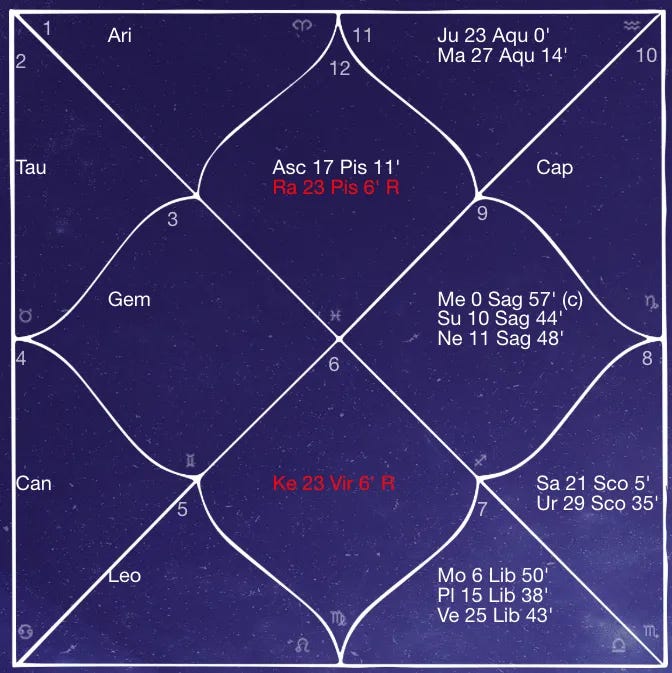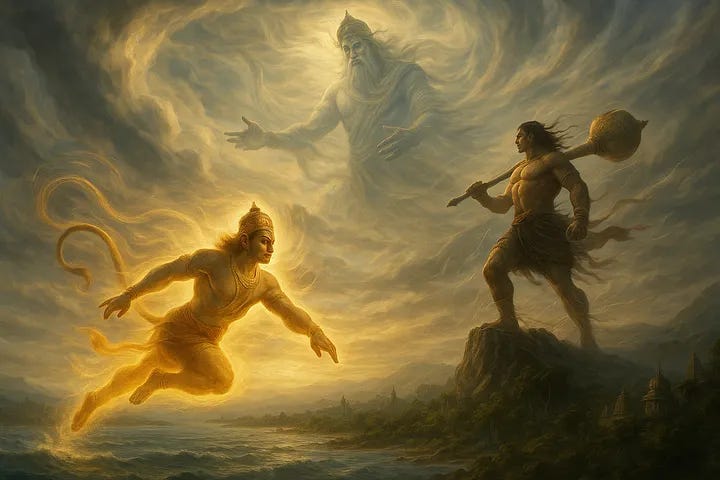Welcome to the 15th Nakshatra, Swati. One quick reminder: If you haven’t read the first two posts in this series, I recommend you start there before continuing to this Nakshatra.
The Basics
Swati Nakshatra spans from 6°40' to 20°00' in Libra, sitting entirely within Libra's airy, balance-seeking domain. This placement infuses Swati with diplomacy, independence, and a constant quest for equilibrium.
The name ‘Swati’ is derived from the Sanskrit ‘Su-Ati’, meaning ‘very good’ or ‘independent one’. This etymology reflects the nakshatra’s essence — freedom-loving, self-reliant, and ever in motion.
The Myth
Swati’s presiding deity is Vayu, the god of wind, who represents the force of movement, transformation, and the breath of life itself — prana. Unlike deities who act through form and fire, Vayu is subtle and invisible, yet his presence can be felt in everything. His energy moves between worlds, interconnecting them. In this way, Vayu mirrors the essential nature of Swati — restless, adaptive, and yet powerful.
Vayu’s mythology is deeply woven into the epic narratives of the Mahabharata and Ramayana. He is the divine father of Hanuman, the monkey god known for his supernatural strength, boundless devotion, and unwavering service to Lord Rama. Hanuman’s leap across the ocean to reach Sita and his ability to grow or shrink in size capture the supernatural potential of the wind. Similarly, Vayu fathers Bhima, the mighty Pandava warrior whose immense physical power and appetite are legendary. Both sons embody facets of Vayu: Hanuman as the refined, devotional aspect of air; Bhima as its raw, forceful expression. Those born under Swati carry energies of both — capable of fierce loyalty and powerful action, yet always seeking freedom and movement.
Swati is also symbolically linked with Saraswati, the goddess of speech, music, learning, and the flowing river of consciousness. Her presence amplifies Swati’s love of refinement, eloquence, and the pursuit of wisdom. Just as wind carries sound, Swati natives may find themselves as transmitters of knowledge, storytellers, or mediators. This dual heritage — of Vayu and Saraswati — makes Swati a nakshatra of both motion and meaning, of wandering and wisdom.
Symbolism
The primary symbol of Swati is a single blade of grass swaying in the wind, representing flexibility, grace, and the ability to bend without breaking. This imagery captures Swati’s core strength — adaptability in the face of change.
An alternative symbol is coral, which grows organically and thrives amidst ocean currents. This symbolizes Swati’s capacity to flourish in diverse environments and her inherent resilience.
Rulerships
Zodiac Rulership — Swati resides entirely within Libra, a sign ruled by Venus. This imbues the nakshatra with qualities of harmony, aesthetics, and relational intelligence. Swati’s Libran influence enhances her diplomatic skills and appreciation for beauty.
Nakshatra Rulership — Rahu, the ruler of Swati, introduces elements of unconventionality, ambition, and a desire to transcend limitations. Rahu’s influence can manifest as a drive for innovation and a tendency to challenge norms.
Deity Rulership — Vayu, as the presiding deity, reinforces Swati’s themes of movement, freedom, and the subtle yet powerful influence of the wind. Vayu’s presence endows Swati with the ability to navigate change gracefully and to inspire transformation in others.
Putting It All Together
Now that we have spent some time going over the nature of Swati, let’s put it all together. Swati embodies several key qualities that define its energetic signature:
Ruled by Vayu: The god of wind represents movement, breath, and subtle transformation. His influence makes Swati dynamic, mutable, and attuned to the unseen currents of life.
Symbolized by a blade of grass: Flexible yet rooted, this symbol speaks to Swati’s resilience in the face of change and her gift for adaptation without losing form.
Associated with Saraswati: The goddess of wisdom and the arts lends Swati a connection to eloquence, refinement, and the pursuit of learning.
Ruled by Rahu: Rahu brings an unconventional, forward-facing energy. He pushes boundaries, disrupts norms, and imbues Swati with a hunger for exploration — both literal and intellectual.
Located in Libra: Swati’s position in Venus-ruled Libra enhances its charm, relational skill, and love of harmony. It also brings a balancing quality, often softening Rahu’s more disruptive tendencies with a desire for connection and aesthetics.
Swati, then, is a nakshatra of wanderers and wayfinders — those who move through the world like wind through the trees, carrying stories, ideas, and change wherever they go. They crave freedom and motion and refuse to be put in a cage.
Moon in Swati

If your Moon is placed in Swati, your emotional world is shaped by the wind’s subtle strength: independent, mobile, and ever attuned to the energy of your environment. You likely experience feelings as something to flow with, rather than fix or contain. There’s a strong need for emotional freedom — you may bristle at anything that feels like a cage, even in close relationships.
Your mind is curious and expressive, often drawn to new ideas, languages, and cultural exchanges. With Rahu’s rulership, there can be a restless hunger for novelty, and emotional stability might come not from stillness, but from the ability to move, adapt, and engage with what’s new.
This placement often brings a gift for clear communication, negotiation, or the arts, especially music or voice. There’s a poetic nature to the way you feel and share, though it may be masked by a tendency to intellectualize emotion. Beauty and balance in your surroundings support emotional clarity. When centered, you move like a breeze: refreshing, insightful, and transformative.
A Quick Example

This chart features Pisces rising, with the Moon placed in Swati Nakshatra in the 8th house, in the sign of Libra.
The Moon in Libra reflects a mind that is relational, aesthetically inclined, and emotionally attuned to harmony and balance. Its placement in Swati Nakshatra adds a wandering, independent spirit — one that seeks clarity through movement, rather than stillness.
With the Moon in the 8th house, emotional depth runs high. This is a placement of transformation, inner excavation, and intimacy with the hidden layers of life. There can be an instinctive pull toward the mystical, psychological, or taboo. Combined with Swati’s airy nature, this points to someone who may intellectualize intensity, yet feel deeply in subtle, often unspoken ways.
As the ruler of the 5th house, the Moon brings emotional creativity and romantic depth into the realm of transformation. This combination also suggests that emotional expression might come through layered storytelling, symbolic language, or nonlinear forms.
Venus’s influence through Libra grants emotional grace and a desire for beauty even in shadowy spaces. Yet Rahu’s rulership creates a drive to push beyond societal norms, making this a person who feels most alive when navigating edges.
Conclusion
Swati reflects Rahu’s questing nature and the airy grace of Libra — blending movement with meaning, independence with diplomacy, and curiosity with refinement. If your Moon is in Swati (or this nakshatra plays a key role in your chart), you likely carry a deep desire for freedom, learning, and harmonious flow — both in your outer life and your inner world.
Things you can embrace: Emotional adaptability, intellectual charm, and the ability to navigate change with grace and insight.
Things you must be cautious of: Scattered focus, relational detachment, or a tendency to flee when depth or discomfort arises.
As always, let astrology be a mirror, not a box. Use it to better understand your rhythms, so you can walk your path with awareness, intention, and a deeper sense of emotional freedom.
Resources:
The Nakshatras: The Stars Beyond the Zodiac by Komilla Sutton
The Nakshatras by Dennis Harness
The Essentials of Vedic Astrology by Komilla Sutton
Nakshatra — The Authentic Heart of Vedic Astrology by Vic DiCara
27 Stars, 27 Gods: The Astrological Mythology of Ancient India by Vic DiCara
Vedic Astrology Simply Put by William R. Levacy










